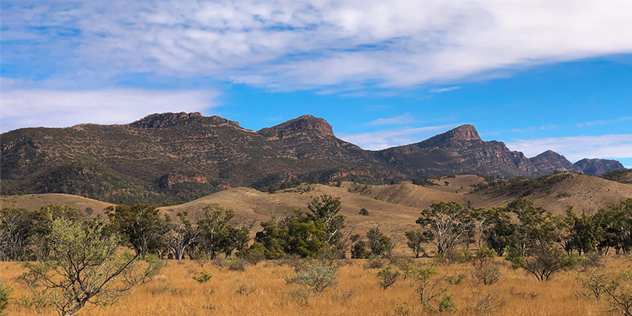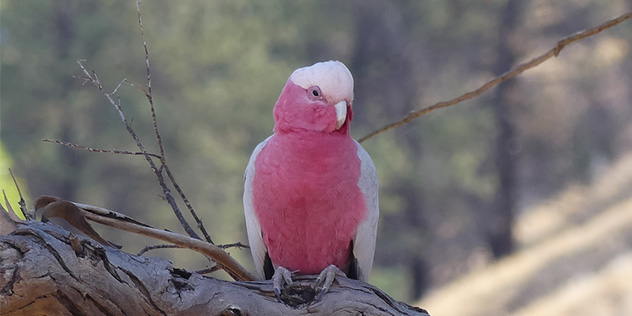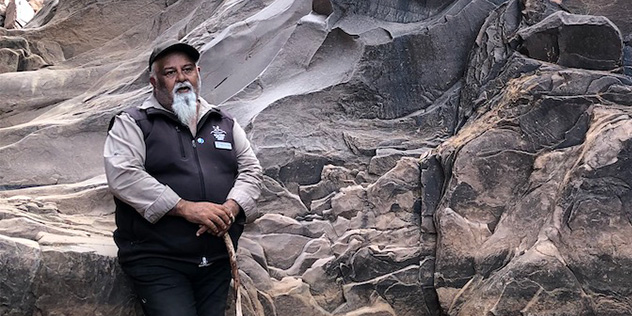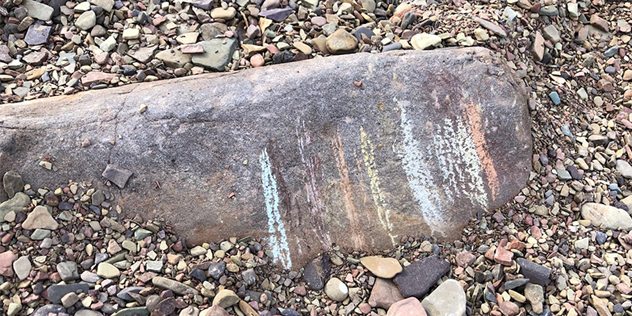
When Mick McKenzie was a Year 1 student, his teacher asked the class how they thought Wilpena Pound was formed. The Adnyamathanha boy thrust up his hand and joked, “It’s where Ayres Rock bounced.” At 17km long and 8km wide, however, the Pound could contain Uluru a half-dozen times over.
Mick is now a field archaeologist and manager of the visitor centre at Wilpena Pound Resort. He recounts the creation myths of the Adnyamathanha (pronounced Ad-na-mut-na) people for visitors. The sides of Ikara (the Indigenous name for Wilpena Pound, meaning ‘meeting place’) are two Akurra, or serpents, who devoured the attendees of a ceremony there. While the natural amphitheatre resembles a volcanic crater or meteorite impact site, geologically it’s deemed an uplifted, eroded basin.
From Adelaide airport I head to the Clare Valley for a night, visiting the Outback Rustic Garden Art store in Roseworthy and photographing the historic bluestone buildings of Auburn. When I arrive in Mintaro, it’s too late to visit Martindale Hall, the grand Georgian sandstone mansion built in the late 1800s, so I head to Mintaro Wines instead.
Producer Peter Houldsworth specialises in hand-pruned, hand-picked and dry-grown grapes. I’m after a riesling, but he convinces me to try his pinot gris, which I buy instead. He creates stunning art-series labels, including the hilarious Flying Doctor Outback Survival Kit series by artist Howard William Steer, whom I met in Broken Hill years ago.
I stay at Bed in a Shed, set amongst vines at Leasingham. Owner and artist Andrew Quixley excels at repurposing recycled timber, corrugated iron and stained glass into a cosy, quirky cocoon. It’s artistically intriguing and visually stimulating, with lemon-and-lime leather tub chairs echoing his abstract oil painting of the terroir. I spend a quiet night in, pairing Andrew’s cabernet shiraz blend with Maggie Beer brie and Barossa Bark crispbread from Watervale General Store.

In the morning, I find Andrew in his Vine Arts studio and we chat for so long that I’m late leaving. En route I also stop to photograph derelict buildings marooned in vast fields of dry stubble – the crewcut remains of grain crops.
Arching pepper trees on Jamestown’s park-sized median strip offer verdant visual relief after kilometres of parched paddocks. At ek-wi-tee Café the delicious house-made quiche is bursting with local vegetables. On the side of RM Williams Way, the highway through town, is a monument dedicated to the man himself. He was born near Jamestown in 1908 and his initials stand for Reginald Murray – a titbit worth remembering for trivia nights. At Orroroo a mob of corrugated kangaroos welcomes road-trippers and on the outskirts of town an enormous river red gum is worth the quick detour.
Wilpena Pound’s peaks loom through my bug-smeared windscreen as I approach Ikara-Flinders Ranges National Park in rapidly dwindling light. My hire car isn’t supposed to be driven between dusk and dawn outside city limits (to avoid animal collision). I’m straining to reach the resort before sundown when a bounding kangaroo misses my rear panel by a whisker. It’s my own fault I’m late – for two days I’ve underestimated the time needed to explore South Australia’s countryside.
Darkness descends as I check-in at Wilpena Pound Resort, the only accommodation within the national park, located just outside the Pound. It has a village-like vibe, with a visitor centre, IGA store, swimming pool and a restaurant that buzzes with camaraderie in the evenings. There are hotel rooms and a campground, but I’ve scored a glamping tent at Ikara Safari Camp, a short walk from the resort hub. My deck has a view of Rawnsley Quartzite peaks that blaze burnished orange at dawn and dusk, a perfect spot for a pre-dinner drink while watching wallaroos, and for post-dinner stargazing, where I witness a huge moon halo.
This is my first visit to the Flinders Ranges and I’m keen to learn about the ancient landscape and Indigenous custodians. I join the nightly Welcome to Country and book all the tours, starting with Yura Udnyu (Our Culture, Your Culture). We walk with Adnyamathanha man Jimmy Neville to Old Wilpena Station, established in 1851.

The pastoral run operated for 135 years and its buildings offer a window into early settler life. ‘Wire became the fingerprint of possession’ states an interpretive sign and Jimmy explains its meaning – the only way the Adnyamathanha could stay on their traditional land was to work for the white farmers, who needed Aboriginal labourers to fence ‘their’ land.
Jimmy shares history in a spirit of reconciliation as we sit within the Ikara art installation, where various quotes from elders are etched into the paving, such as: “Don’t dwell on the past, but acknowledge it to make the future better.” It’s wonderful that the Adnyamathanha are now joint-owners of Wilpena Pound Resort and co-manage the national park.
Walking back, we’re dwarfed by venerable river red gums thought to be more than 500 years old. Stupendous trunks, some with burnt boles forming human-sized cavities, support numerous branches big enough to be large trees on their own. It was a river red gum (eucalyptus camaldulensis) that Australian photographer Harold Cazneaux immortalised in 1937 with his image ‘The Spirit of Endurance’. Known as the Cazneaux Tree, it still stands nearby.
Continuing the pastoralist theme, I walk to Hills Homestead, inside the Pound. It’s a shady two-hour return stroll beneath river red gums whose trunks are mottled mosaics of mossy greens, pearlised creams and lichen greys. The dry Wilpena Creek bed is jammed with Jenga-style log jumbles, testament to the ferocity of past floods. Birds chitter around a tranquil waterhole and wild goats fossick in the undergrowth. Reaching the small stone homestead, I’ve entered the Pound via Wilpena Gap without realising it.
Sheep were introduced to the natural enclosure (hence the ‘pound’ naming) in 1851, followed by wheat, but they ultimately failed due to overstocking, drought and flood. Climbing to the lookouts on Wangara Hill shows native trees now regenerating on the Pound floor, including slow-growing callitris, a cypress-like native pine known locally as ‘vimba’, whose termite-resistant timber was stripped from the plains for fencing.

With 360-degree views of rolling red hills, backstopped by serrated mountain peaks, Stokes Hill Lookout is popular at sundown. Tonight’s sky is a lava-flow of molten orange and yellow in the west and a smudged pastel of smoky mauves, pinks and greys in the east. “That’s a bloody ripper!” enthuses Mick of the kaleidoscopic light show on our Sunset Tour. It’s the climax to our evening that started with nibblies and sparkling wine around a topographically-accurate 3D bronze monument of the Pound. Mick pours water onto it to represent rainfall, and we watch it overflow through Wilpena Gap, where I walked yesterday, and flush down Wilpena Creek.
On a scenic flight next morning I see the Pound full scale. Massive though it is, it’s but a pucker in a sinuous chain of ranges including Heysen and ABC, which rupture the landscape like the spines of semi-submerged crocodiles. Striated ridges are a rainbow of coloured sandstone, limestone and siltstone. We skim the Pound’s highest peak, St Mary, at 1171 metres, and swoop over Mount Ohlssen Bagge’s 941 metres.
Hiking to the top of Mount Ohlssen Bagge, I understand why Adnyamathanha means ‘rock people’, and why the trail is closed at the height of summer. Naively, I start near lunchtime, trudging up the stony track where stunted shrubs offer scant shade from the sun. The upper reaches become a rock-scramble over mammoth, heat-radiating boulders, but the reward is expansive views over the plains and Pound.
The next day I join Jimmy Neville on the Gorgeous Gorges 4WD tour through Brachina and Bunyeroo gorges. Dubbed the ‘Corridor Through Time’, the geological jaunt traverses about 130 million years of geology. There’s interpretive signage for self-drivers, but Jimmy highlights things I’d never have seen, like rippled rocks of ancient sea beds, fossilised stromatolites, and reef-building archaeocyatha fossils. He also spots endangered yellow-footed rock wallabies camouflaged among the cliffs. With endearing black-chiselled faces, hunched shoulders and paws poised in front of white-aproned chests, they remind me of Old Mother Hubbard.
On the Yura Mulka Sacred Canyon walk, Mick once again takes us on a spiritual journey into the realm of his Adnyamathanha ancestors as we follow their footsteps through a tranquil gorge. It’s a humbling, contemplative time as Mick interprets engravings on the rock wall towering above us, including megafauna tracks.
Access to Arkaroo Rock is about 17km from the resort, so I stop on my drive back to Adelaide and take the 3km loop walk. With its fang-style overbite, the rock is eerily snake-like, but that hasn’t deterred vandals, and the rock paintings are now behind wire. The drawings are unlike others I’ve seen and I wish Mick or Jimmy were here to interpret them.
At Hawker, tin soldiers stand guard at the rose-perfumed War Memorial Gardens, which I’d missed as I whizzed through on my way to the Pound. But visiting Jeff Morgan’s gallery post-Wilpena gives me a greater appreciation for his room-sized outback panorama paintings, featuring landscaped rock foregrounds that create an immersive 3D effect. My favourite is the 33-metre, 360-degree painting of Wilpena Pound as viewed from St Mary Peak, which took 13 months to complete. Geologists and fossickers will also appreciate the rooms filled with rocks, gems and fossils.
I continue to the Spencer Gulf and the Ellen Hotel in Port Pirie. Opened in 2016 in what was once the town hall, the petite luxe hotel is now owned by Dean Vegas, a well-known Elvis tribute artist. With evocatively named cocktails like Love Me Tender and All Shook Up, I’m hoping for a spontaneous performance over dinner, but Elvis has left the building – he’s entertaining interstate.
Next morning, I check out the mural trail and visit the Regional Tourism & Arts Centre to see Shakka, a 5.5-metre life-size replica of a great white drowned after entanglement in a snapper fishing line. I forgo the Virtual Reality Shark Cave Diving though, with the excuse that I need to get to Adelaide before the forecast storm.
Hotel Indigo, Adelaide’s new kid on the block, resides in a laneway opposite Adelaide Central Market. The boutique hotel pays homage to the city’s festivals and is decorated with vibrant posters of events past. My light-filled room appropriately features a Writers’ Festival banner. Rain closes the rooftop bar, Merrymaker, but the Market & Meander restaurant and bar is buzzing with locals as I tuck into a Spencer Gulf prawn pasta. It’s the perfect cosy spot to bookend my South Australian sojourn.

The ancient landscape of the Flinders Ranges attracts visitors for its rugged beauty, but it’s also a geological drawcard for scientists. Geologists, palaeontologists and biologists study the 500-million-year-old basin and the fossils within, which are of worldwide significance.
In June 2021, the South Australian Government designated its newest national park, Nilpena Ediacara National Park, about a two-hour drive from Wilpena Pound, to protect its fossils depicting the early evolution of complex life. NASA also funds research there to learn how life evolves on a planet. The Park is part of a push to have the Flinders Ranges World Heritage listed.